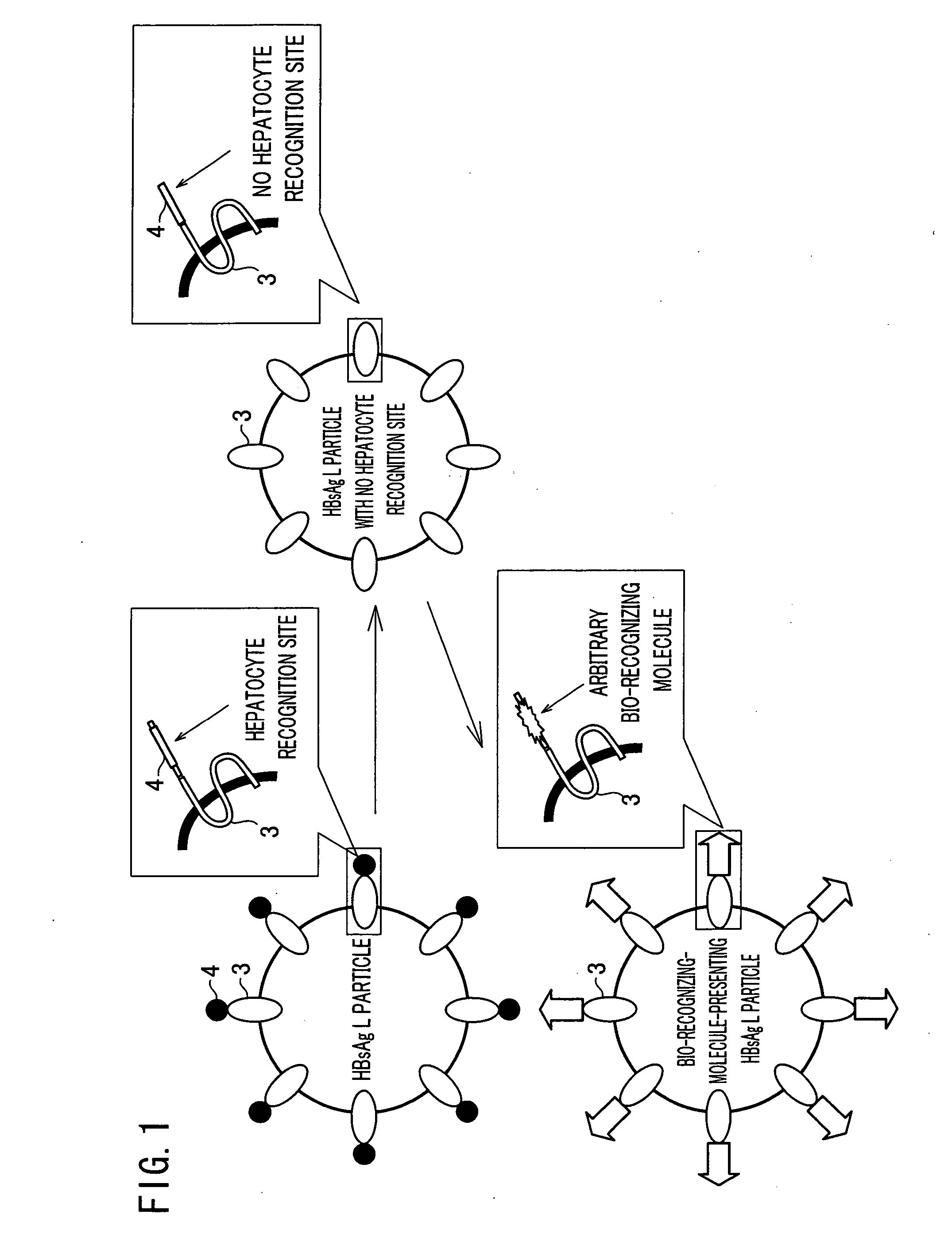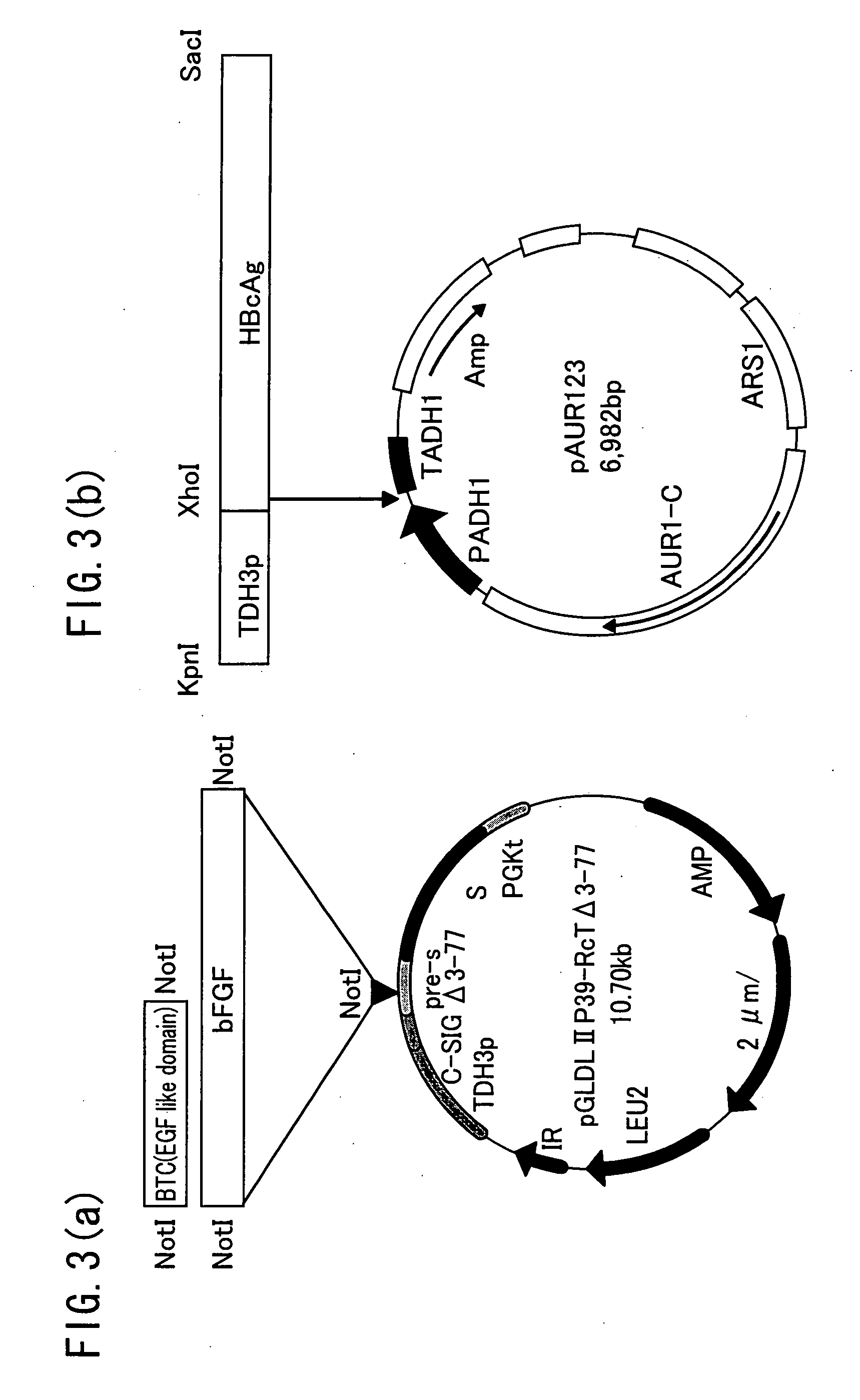Hollow nanoparticles of protein and drug using the same
- Summary
- Abstract
- Description
- Claims
- Application Information
AI Technical Summary
Benefits of technology
Problems solved by technology
Method used
Image
Examples
example 1
[0063] The following explains a preparation method of the modified HBsL protein. As shown in FIG. 3(a), the HBsAg L protein-expression-vector according to the Patent Document 1 above, reported by the inventor of the present invention, was expressed in yeast. The vector of pGLDL II P 39-RcT Δ 3-77 was prepared by deleting the pre-S region of pGLDLII P39-RcT(3rd amino residue to 77th amino residue, and inserting genes encoding BTC or bFGF using restriction enzyme NotI. As a result, HBsAg L protein that displays BTC as a bio-recognizing molecule, that is BTC displaying HBsAg L particles, or bFGF displaying HBsAg L particles were obtained.
example 2
Preparation of HBcAg Yeast-Expression-Plasmid
[0064] (2-1) Insertion of Promoter TDH3 into a Plasmid
[0065] A DNA fragment of the promoter TDH3 incorporated in the wild-type HBsAg expression plasmid pRS405-2-LAG was amplified by PCR method. This PCR was performed with a reaction liquid whose composition is shown in Table 1, with the use of primers of sequence numbers 3 and 4, respectively as the primers (+) and (−).
TABLE 1PCR: HBcAg10X LA PCR Buffer II (Mg2+free)8μlMgCl2 (25 mM)8μldNTP mixture (2.5 mM each)8μlDNA template (45 pg / μl)8μlPrimer (+)0.8μlPrimer (−)0.8μlTaKaRa LA Taq (5 U / μl)0.8μlOtsuka distilled water45.6μlTotal80μlPCR: TDH310X LA PCR Buffer II (Mg2+free)8μlMgCl2 (25 mM)8μldNTP mixture (2.5 mM each)8μlDNA template (10 ng / μl))8μlPrimer (+)0.8μlPrimer (−)0.8μlTaKaRa LA Taq (5 U / μl)0.8μlOtsuka distilled water45.6μlTotal80μl
[0066] The reaction liquid was divided into four portions, three of which were subjected to PCR reaction in such a manner that: after heating for 30 se...
example 3
Coexpression of HBcAg and HBsAg in Yeast
[0073] The HBsAg L protein expression vector of Example 1 and the HBcAg expression vector of Example 2 were cotransformed to each other. In other words, the vectors were transformed to S. cerevisiae AH22R-strain by the following spheroplast method (Albert et al., 1978).
[0074]S. cerevisiae AH22R-strain was inoculated on YPDA agar medium (see Table 2 for the composition) and cultivated for a few days at 30° C., and the resulting colony was subjected to preincubation overnight in 50 ml YPDA medium (see Table 2 for the composition) at 30° C. After the preincubation, the product was inoculated in 50 ml YPDA medium to obtain the condition: OD600=0.05 for the beginning of the main incubation, and then was further cultivated for 8 hours at 30° C. until OD600=0.4-0.8. Thereafter, the culture solution x 4 ml is divided into 15 ml tubes (IWAKI), and then, the fungus body was collected by centrifugation at 4° C. at 2000 rpm for 5 min using a multi-place...
PUM
| Property | Measurement | Unit |
|---|---|---|
| Fraction | aaaaa | aaaaa |
| Fraction | aaaaa | aaaaa |
| Fraction | aaaaa | aaaaa |
Abstract
Description
Claims
Application Information
 Login to View More
Login to View More - R&D
- Intellectual Property
- Life Sciences
- Materials
- Tech Scout
- Unparalleled Data Quality
- Higher Quality Content
- 60% Fewer Hallucinations
Browse by: Latest US Patents, China's latest patents, Technical Efficacy Thesaurus, Application Domain, Technology Topic, Popular Technical Reports.
© 2025 PatSnap. All rights reserved.Legal|Privacy policy|Modern Slavery Act Transparency Statement|Sitemap|About US| Contact US: help@patsnap.com



